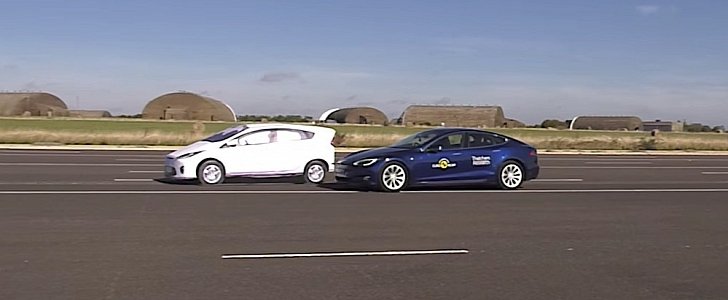Ten cars were put through their paces by the Euro NCAP in recent weeks not to see how they can withstand crashes, but to test the performance of the automated driving systems (ADS) deployed in them. Among these cars, the Tesla Model S was pitted against models like the BMW 5 Series and the Nissan Leaf.
The need to test these systems arose from the finding that car buyers, in general, have no idea what ADS technology does, and more importantly they mix up the technologies.
A staggering 70 percent of car drivers – Euro NCAP does not say how many people took part in the survey – are under the impression that cars that can drive themselves exist today, and they can already be purchased.
Of course, that’s not the case, but this finding shows an utter lack of knowledge when it comes to what ADS can and cannot do, what type of ADS exist and in which cars they are deployed.
Let’s take Tesla’s Model S, for instance, a model superbly powered by the world famous Autopilot suite of features, the same deployed on all Tesla models.
The car’s Autopilot is so good at its job that it can “create the potential for over-reliance,” as Euro NCAP says. That means that drivers find the Autopilot driving mode so accurate, permissive and comfortable that at times they forget the system is there to assist, not drive itself, and human input is not only required but mandatory.
This self-complacency also stems from the way in which Tesla chooses to advertise Autopilot, Euro NCAP claims. The fact that the promotional clips released by Tesla suggest autonomy, a mismatch “between more accurate information included in the user manual and more misleading information in marketing materials” is created.
The name of the system itself, Autopilot, “implies a fully automated system where the driver is not required,” but in all the test scenarios Euro NCAP used, Autopilot proved to be anything but.
Euro NCAP also criticizes the fact that Autopilot is not geofenced to stop users from deploying it on roads other than highways, where it is only meant to be used.
The most dangerous attribute of the Autopilot is that it does not allow driver input at all when trying to avoid a pothole, for instance, prohibiting the human to deviate from the lane centering path. Autopilot was found to disengage only when steering torque is felt.
The fact that a hands-off warning is in place is a good thing, but that's there only for show and to abide by the law, as a simple nudge of the steering wheel help avoid Autopilot deactivation.
“Overall, the Tesla system is primarily in control with a risk of driver becoming over-reliant on the system,” concludes Euro NCAP.
You can read all the observations made by Euro NCAP regarding Autopilot in the document attached below.
A staggering 70 percent of car drivers – Euro NCAP does not say how many people took part in the survey – are under the impression that cars that can drive themselves exist today, and they can already be purchased.
Of course, that’s not the case, but this finding shows an utter lack of knowledge when it comes to what ADS can and cannot do, what type of ADS exist and in which cars they are deployed.
Let’s take Tesla’s Model S, for instance, a model superbly powered by the world famous Autopilot suite of features, the same deployed on all Tesla models.
The car’s Autopilot is so good at its job that it can “create the potential for over-reliance,” as Euro NCAP says. That means that drivers find the Autopilot driving mode so accurate, permissive and comfortable that at times they forget the system is there to assist, not drive itself, and human input is not only required but mandatory.
This self-complacency also stems from the way in which Tesla chooses to advertise Autopilot, Euro NCAP claims. The fact that the promotional clips released by Tesla suggest autonomy, a mismatch “between more accurate information included in the user manual and more misleading information in marketing materials” is created.
The name of the system itself, Autopilot, “implies a fully automated system where the driver is not required,” but in all the test scenarios Euro NCAP used, Autopilot proved to be anything but.
Euro NCAP also criticizes the fact that Autopilot is not geofenced to stop users from deploying it on roads other than highways, where it is only meant to be used.
The most dangerous attribute of the Autopilot is that it does not allow driver input at all when trying to avoid a pothole, for instance, prohibiting the human to deviate from the lane centering path. Autopilot was found to disengage only when steering torque is felt.
The fact that a hands-off warning is in place is a good thing, but that's there only for show and to abide by the law, as a simple nudge of the steering wheel help avoid Autopilot deactivation.
“Overall, the Tesla system is primarily in control with a risk of driver becoming over-reliant on the system,” concludes Euro NCAP.
You can read all the observations made by Euro NCAP regarding Autopilot in the document attached below.



